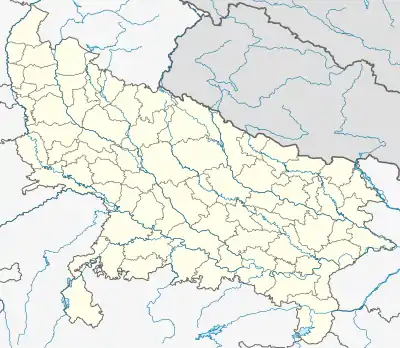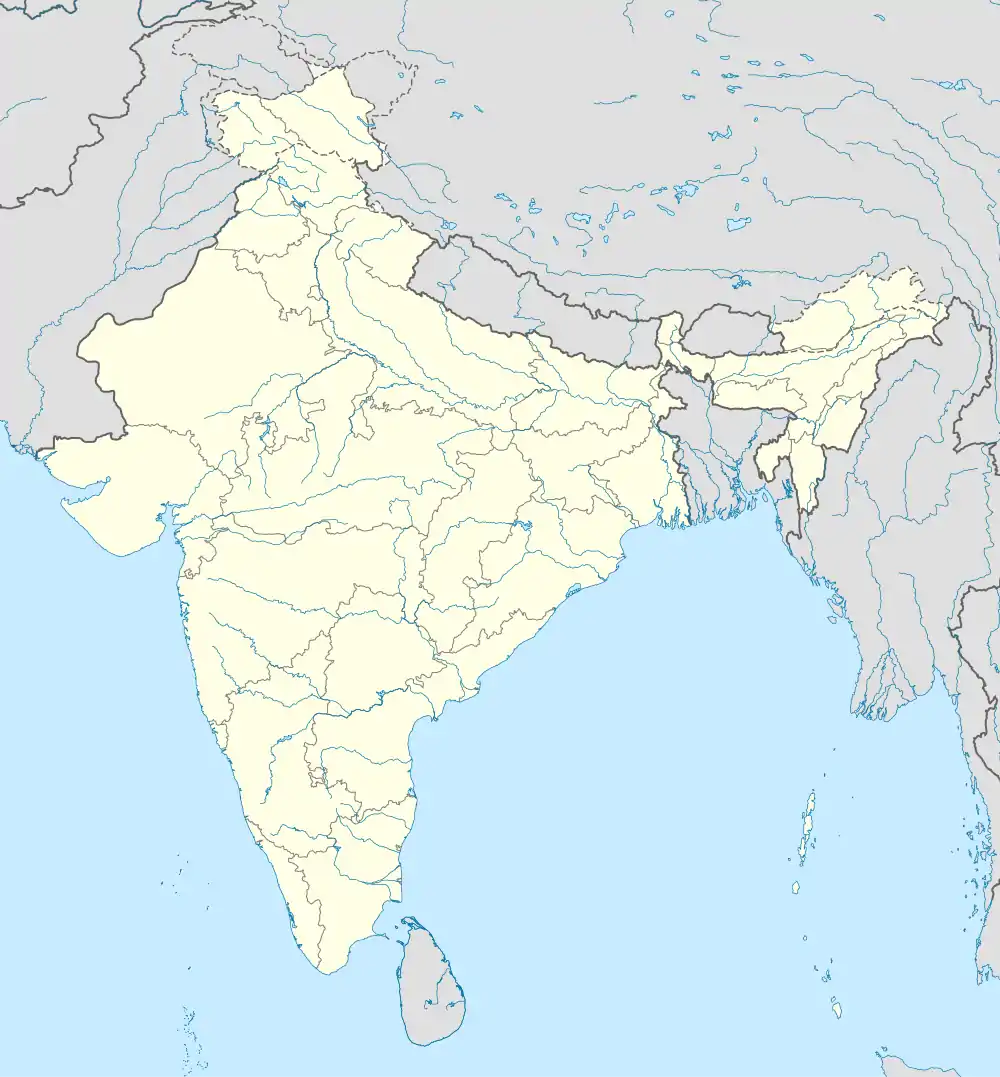Rataul
Rataul is a village located in the Khekra tehsil, in the Baghpat district, Uttar Pradesh state, India.[1] It is 25 km (16 mi) from the Indian capital of Delhi, and also 7 km (4.3 mi) from Loni.
Rataul | |
|---|---|
Village | |
 Rataul  Rataul | |
| Coordinates: 28°50′N 77°21′E | |
| Country | |
| State | Uttar Pradesh |
| District | Baghpat |
| Tehsil | Khekra |
History
In colonial times, the local area judiciary court operated in Rataul. Many of its people were active in the Indian Freedom Movements, and some Rataulis took part in Khilafat Movement.
past of Rataul Rataul is one of the ancient village of Meerut district where Indian culture flourished and flourished. After Harsha, Rashtrakutas, Pratiharas, Gahadwals, Tomars and Chauhans ruled this region. The Gahadwal rulers were called Rathores. Legend has it that the word 'Rathore' itself was a morpheme 'Rataul'. Here too, similar shards of Ravana alias Bada village have been found nearby, due to which it is quite possible that the inhabitants of the same ancient tribe may have built these village-towns. The black paintings on top of Takre Lal are of Harappan culture and wares recovered from the excavations of Kalibangan. Large brown pieces have also been found in these characters. The ornamentation above them is varied and it is indicative of the artistic development of such characters. nb P . Fragments have also been found from which it is estimated that the ancient civilization of Rataul was developing and flourishing till the period of history. During the construction of the house, excavation found a golden spire with beautiful ornamentation on which the roof of the temple rested. It is known from the art of this stone and the sculptures on it that it was installed in a huge temple of the Gupta period. There is an image of him holding a urn in his hand, which indicates that it may possibly be of a Bodhisattva holding in his hand the sacred bone-carrying vessel found in sputans. Other figures are in a flying posture by lifting a weight. Some coins have also been received which will be around 25-30. These coins appear to be of silver mixed with copper and are punchmarked. Certainly before Ashoka. There are some symbols on these which are hard to identify clearly. It is clear that the rataul has hidden the remains from the Harappan period to the later medieval period. It is also clear from this that this village has been inhabited and desolate many times. The incident of the Soti (Srotriya) Brahmins going from here to elsewhere is historical in itself, but it is also an important evidence of the antiquity of Rataul. What would have been the name of Rataul in ancient times, it cannot be said, but due to the presence of many temples and the presence of Shrotriya Brahmins, the kind of reputation of Rataul in ancient times can be easily estimated. There will be no difficulty in studying it from the duties and activities of the Shrotriya brahmins. Through Veda-vidya, celibacy and Ishwaropasana, man becomes srotriya (disciple of Veda Vidya) Parameshthi (Samvidhata) and Agni-leader and these qualities are 99.
Being adorned with it, he is called the creator of the era. For attaining the position of Shrotriya, it is necessary to practice Brahma-Ved-Vidya, celibacy and yoga, life-free, a great scholar who has attained Brahm, ascetic Tyagi is a great man who adorns the position of Shrotriya. For attaining the position of Kshatriya one has to study and follow the Vipra Veda, its branch Kalpa - Brahman texts and 6 appendages of the form of Philosophy. The theologians and essayists have divided the brahmins on the basis of karma. According to this, a srotriya brahmin is one who has studied only one Veda and Vedanga and regularly performs the Shatkarmas of the brahmins. Among these deeds are study of Vedas, teaching, pious conduct, not to misrepresent, being afraid of sins, following non-violence, keeping fire in the house, following religious rules, protecting cows and staying away from craving and greed. Due to the abundance of listeners, Rataul must have been a great center for reading and performing Yagya in ancient times. The confirmation of this fact becomes more evident at the time that when we consider their descendants whose ancestors were forced to leave this place by Muslim invaders, in the present times to fulfill their promise (establishment of temple and undertaking to perform Yajna and to do so). But it is only in the year 1954 that the dream of taking food and water from this place came true. Dhruv Rashtrakuta invaded the Ganges-Yamuna doab and in the celebration of his victory, it is said that he gave the Ganga-Yamuna motif in the Empire - Signs (paragraphs) also added. 814 AD Due to the internal strife of the Rashtrakutas after the death of Govind III in the early 2000s, the Pratihara ruler Nagabhatta II was relieved of their danger. The Gwalior inscription shows that Nagabhatta II had established a vast empire, but the importance and power of the Pratihara-kul had been destroyed by the time of the governor's accession around the last decade of the tenth century. After the fall of the Pratihara Empire, there were frequent attacks by Muslims in the Ganges-Yamuna doab. In this way, when the earth was encroached by destructive attacks, then a person named Chandra Dev got up and put an end to the suffering of the subjects through his Vikram. In his inscriptions, Chandra Dev assumed Param Bhattaraka Maharajadhiraja, the emperor of Parameshwara, and called himself a trata of pilgrimage places of Kashi, Uttarkaushal (Faizabad), Jilar Kushik (Kanauj) and Indrasthan (Delhi). • The empire expanded under the rule of Govind Chandra, the famous ruler of the same dynasty, but the Chahamana rulers clashed with his son Vijay Chandra, and the Chahamana ruler Vigraraj Visaldev snatched Delhi and the surrounding region from him. • Vigraharaj IV Bisaldev (1153-64 AD), the Chahamana ruler of Shakambhari,
He captured all the land between the Himalayas and the Vindhyas. Doctor . Harihar Niwas Dwivedi in his well-known book "Tomar of Delhi" has proved that at the time of Prithviraj Chauhan, there was definitely an independent power of Tomars over Delhi. Well-known historian Dr. Raghuveer Singh has also given his support to this view. Although it is not the goal here to write in more detail on this disputed subject, however, it is confirmed by the inscription written on Chahaddev copper plate obtained from Rataul that Chauhan (Chaman) dominated the historical Rataul. From the above facts it becomes clear that Rataul Which is a site of Ganga-Yamuna doab itself, was a village of Ashoka the great, art-loving Guptas, Harsha's empire of Vardhan dynasty and after Harsha the Rashtrakutas, Pratiharas, Gahadavalas and Chauhans were under the suzerainty of Raja Bhoj in the 6th century. and his son Mahendrapala ruled in this region. Both these rulers were worshipers of Bhagwati. The Shakti sect became strong during their reign. They worshiped Shakti in various forms such as gentle, fierce and mother. under the rule of rulers Hindu culture continued to flourish in Rataul and till the 11th century, this Hindu majority place was religiously very sacred and far and wide for Hindus. The existence of 52 small and one big temple is accepted by both Hindus and Muslims on the legends. Due to its splendid opulence and its proximity to Delhi, this region also attracted foreign invaders towards itself. The religious invaluable fund was destroyed by the foreign invaders on the strength of the force of violence and forced the cool people settled here to leave their native land. Chauhan ruler Prithviraj III (1676-62 AD) was defeated by Mohammad Ghori in the battle of Tarabari in 1662 AD. defeated in Prithviraj ran away from the battlefield to save life, but was caught and killed by Sarasuti (Saraswati). Mohammad Ghori also captured Ajmer and Delhi. At this time the natives of many places left their native places. The same happened in Rataul village also. The cultural heritage of this region was destroyed by Ghori, temples and idols were ruined. The Hindus, especially the Shrotriya Brahmins, opposed this bigotry. He fought whole-heartedly against the Islamists, but without getting any control, before leaving the birth place, took an oath that he would not take back the land occupied by the invaders until he took back his beloved land and built a temple. Will drink water and will not eat food. The Soti (Srotriya) Brahmins who had fled from different parts of the Ganga-Yamuna doab had fulfilled their pledge to establish a Shiva temple in the east of Rataul village in 1954. Rataul Three, four and five on March 5, 1654, the Shrotriya Brahmins gathered here about twenty
Thousands of people were present and took out a procession and gave peace to the souls of their ancestors. • Rataul is mentioned twice in the pages of history during the period of Alauddin. 1266 AD The Shahana of Rataul, Haji Maula, had captured the throne of Delhi for a few days, although the influence of Haji Maula was overthrown and the Shahana of this place dared to get the kingdom. For the maintenance of almost temples and precious idols, only a Hindu king could fulfill immense wealth. There is a legend of a tunnel in the east of the village to the village of Sharfabad, situated on the Hindon river, five and a half kilometers from the eastern part of the johad and it is said that through the tunnel the queens of the then king used to go to the river Hindon for bathing. Was . Rataul was in the province of Delhi during the time of Akbar. In the latter half of the eighteenth century, the influence of Marhatho increased in this area. Along with the Marathas, the Sikhs also started plundering here. After the third battle of Panipat and after the death of Najibuddaula, Shah Alam II made a treaty with Mahadji Sindhia on 15 February 1771 and this area was received by Mahadji. On 30 December 1803, this area became subject to the British by the treaty of Surji Arjun. On 30 December 1803, by the treaty of Surji Arjun, this area became under the British. At this time this area was snatched from Daulatrao Scindia. From 1804 to 1806, this area was under the Resident of Delhi. 1818 AD Meerut was made a district in 1853 AD. The district came into its present form with minor changes. 1857 AD There is no description available of what was the role of Rataul in the revolution. But being in the area between the capital Delhi and Meerut, there must have been some upheaval. The revolution was crushed and the English grip tightened. 1604 AD Munshifs were appointed in the villages by the British Government. Like Asara, Bhagot, Kirthal, Johri and Sujara in Rataul also Munshif's U.P. Village Panchayat Act. Rataul played a role in the freedom movement. On May 6th and May 14th, three artistic Balmiki Ghars on May 10th and 12 feet out of the pit being dug for taps • Valuable and rare statues of ancient importance have reaffirmed Rataul's historicity and completeness importance on the truth of many legends Went. Historical evidence has been presented for these. Subordinate courts were established but in 1620 AD. In the villages, these courts are not particularly exposed by eliminating any idols in the Valmiki settlement.
Agriculture
More than 200 varieties of mangoes have been grown in Rataul since about 1900 CE, and many are exported around the world. These have been awarded the "king of mangoes" international award many times.
References
- "Local Government Directory - All Villages of Baghpat District, Uttar Pradesh State". District Baghpat Official Website.
https://www.census2011.co.in/data/village/119533-rataul-uttar-pradesh.html